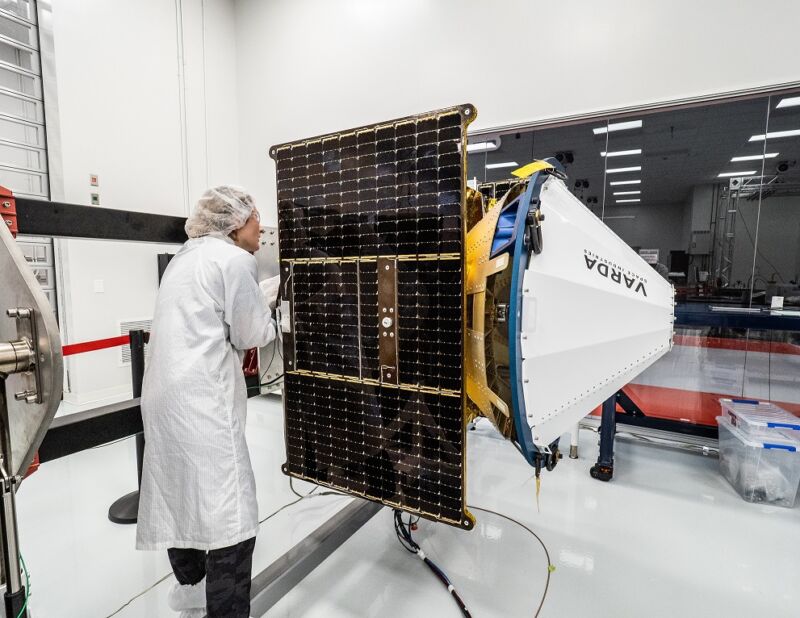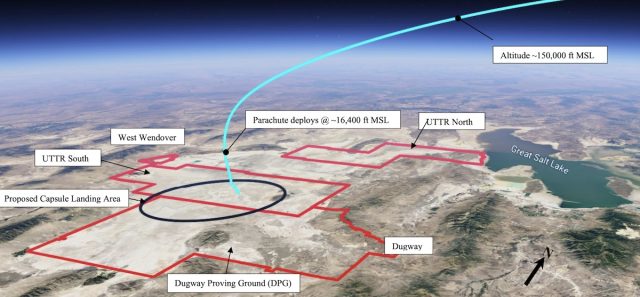
Enlarge / Varda Space’s first “Winnebago” spacecraft, called W-Series 1, before its launch June 12.
The co-founder of California-based startup Varda Space Industries says his company’s first space mission—a miniature lab that has grown crystals of the drug ritonavir in orbit—is on track to end in the coming weeks with a first-of-its-kind re-entry and landing in Utah.
Varda’s spacecraft launched June 12 as part of a rideshare mission on a SpaceX Falcon 9 rocket, then completed several weeks of checkouts before starting a 27-hour drug-manufacturing experiment last week. When ground controllers gave the go-ahead, the mini-lab began growing crystals of ritonavir, a drug commonly used to treat HIV.
The experiment’s 27-hour run was completed on June 30, and data downlinked from the spacecraft showed everything went well.
“For the first time ever, orbital drug processing happened outside of a government-run space station,” Varda tweeted. “This is our first step in commercializing microgravity and building an industrial park in LEO (Low Earth Orbit).”
“Space drugs have finished cooking baby!” tweeted Delian Asparouhov, Varda’s co-founder.
Asparouhov, who established Varda in 2020 with former SpaceX engineer Will Bruey and scientist Daniel Marshall, said Friday he is thrilled with the progress of the demonstration mission.
“One of the critical parts of pharmaceutical processing is being able to maintain appropriate temperature ranges for extended periods of time,” Asparouhov told Ars. “It was exactly per our expectations, which is really great to see.”
Varda is planning a sequence of satellite missions. The spacecraft currently in orbit is the first of Varda’s Winnebago series, designed to bring pharmaceutical research specimens back to Earth for laboratory analysis and eventual commercial exploitation.
The roughly 660-pound (300-kilogram) satellite was built in partnership with Rocket Lab, which supplied a solar-powered carrier module, or bus, providing electricity, communications, propulsion, and attitude control. Varda built a nearly 3-foot-diameter (1-meter) re-entry capsule mounted to the side of Rocket Lab’s satellite platform.

Enlarge / This chart from an FAA environmental assessment shows the expected trajectory of Varda’s re-entry vehicle as it approaches the Utah Test and Training Range.
Sometime in the next few weeks, Rocket Lab’s ground team will uplink a command to fire the spacecraft’s thrusters for a braking maneuver to drop the satellite out of orbit, setting it on a course to plunge back into the atmosphere and target a landing at the US military’s Utah Test and Training Range southwest of Salt Lake City.
Varda’s nearly 200-pound re-entry capsule will separate from its carrier craft before re-entry. An ablative carbon-based heat shield material developed by NASA will protect the capsule from scorching hot temperatures as it streaks through the atmosphere, approaching the desert landing zone from the north. Then, if all goes according to plan, the re-entry vehicle will deploy a 6.2-foot-diameter (2.1-meter) main parachute to slow its velocity for a relatively gentle landing.
FAA license pending
Varda is now working with Rocket Lab, the Federal Aviation Administration, and the military to schedule the mission’s return to Earth. The landing window opens July 17, but the actual return date is likely to move to later this month, he said.
“Now, we’re more in the phase of getting everything lined up between the satellite performing the deorbit burn, as well as the regulatory partners helping with airspace control, all the way down to the military resources that will be helping us with the actual retrieval on the range,” Asparouhov said in an interview.
Varda and its partners completed a rehearsal for the recovery in Utah in early June, about a week before the mission’s launch.
>>> Read full article>>>
Copyright for syndicated content belongs to the linked Source : Ars Technica – https://arstechnica.com/?p=1952343































